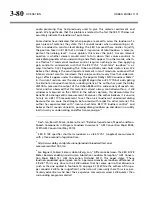
3-80
OPERATION
ORBAN MODEL 1101
audio processing they had previously used to give this material excitement and
punch. We hypothesize that this problem is related to the fact that BS.1770 does not
accurately indicate the loudness of pure tones.
Some studies have indicated that when people are asked to assess the loudness of a
given piece of material, they state that it sounds louder when underscoring or ef-
fects are added to constant-level dialog. The EBU has used these studies to justify
the position taken in R 128 that a listener’s impression of total loudness is more im-
portant than dialog level
. In our opinion, this misses the point. A more relevant
question is whether viewers would want to turn down their volume controls to
make dialog quieter when underscoring and effects appear. (In other words, wheth-
er effective TV commercial loudness control requires nothing more than applying
gain control to commercials such that the BS.1770-2 “short-term” loudness
is al-
ways limited to 0 LK.) Regarding this, Orban and Dolby Labs hold similar views. We
believe that dialog is the most important element in most television audio and that
listeners do not want to turn down their volume controls every time that underscor-
ing or effects appear under the dialog. The popular Dolby LM100 Loudness Meter
in its current revision uses the same Leq(RLB) algorithm as BS.1770 but adds gating
to eliminate non-speech material, including silence. The author has used the Dolby
LM100 to measure the output of the Orban 8685 with a wide variety of speech ma-
terial, and has observed that this material is almost always controlled within a
±
1 dB
window as measured on the LM100. In the author’s opinion, this demonstrates the
benefits of a dialog-centric measurement. Moreover, the author believes it is unwise
to rely on a BS.1770 measurement to set the on-air loudness of unadorned dialog
because this can cause the dialog to be too loud with respect to other material. The
author has experimented with “inverse short-term BS.1770 loudness control” and
believes that it sounds unnatural, pumping dialog loudness up and down in a subtly
inartistic way as underscoring and effects come and go.
11
Dash, Ian; Bassett, Mark; Cabrera, Densil, “Relative Importance of Speech and Non-
Speech Components in Program Loudness Assessment,” AES Convention Paper 8043,
128th AES Convention (May 2010).
12
EBU R 128 specifies short-term loudness as a BS-1770-1 (ungated) measurement
with a three-second integration time.
13
http://www.dolby.com/professional/products/broadcast/test-and-
measurement/lm100.html
14
See Begnert, Fabian; Ekman, Håkan; Berg, Jan, “Difference between the EBU R-128
Meter Recommendation and Human Subjective Loudness Perception,” AES Conven-
tion Paper 8489, 131
st
AES Convention, (October 2011). This paper states, “These
loudness-equalized signals gave rise to a perceived maximum loudness difference of
2.8 dB.” This is very close to the 3 dB number that has come up in other discussions
(such as the one quoted in footnote 10 on page 3-79). While the authors of this pa-
per consider 3 dB to be insignificant, others do not necessarily share this view, par-
ticularly advertisers who hear their expensive commercials aired 3 dB quieter than
surrounding program material!
Summary of Contents for Optimod-PC 1101
Page 4: ......
Page 14: ......
Page 121: ...OPTIMOD PC OPERATION 3 1 Section 3 Operation Figure 3 1 The OPTIMOD PC Control Application...
Page 192: ...3 72 OPERATION ORBAN MODEL 1101...
Page 204: ......
Page 210: ......
Page 212: ...5 2 UNINSTALLATION ORBAN MODEL 1101...
Page 236: ......
















































